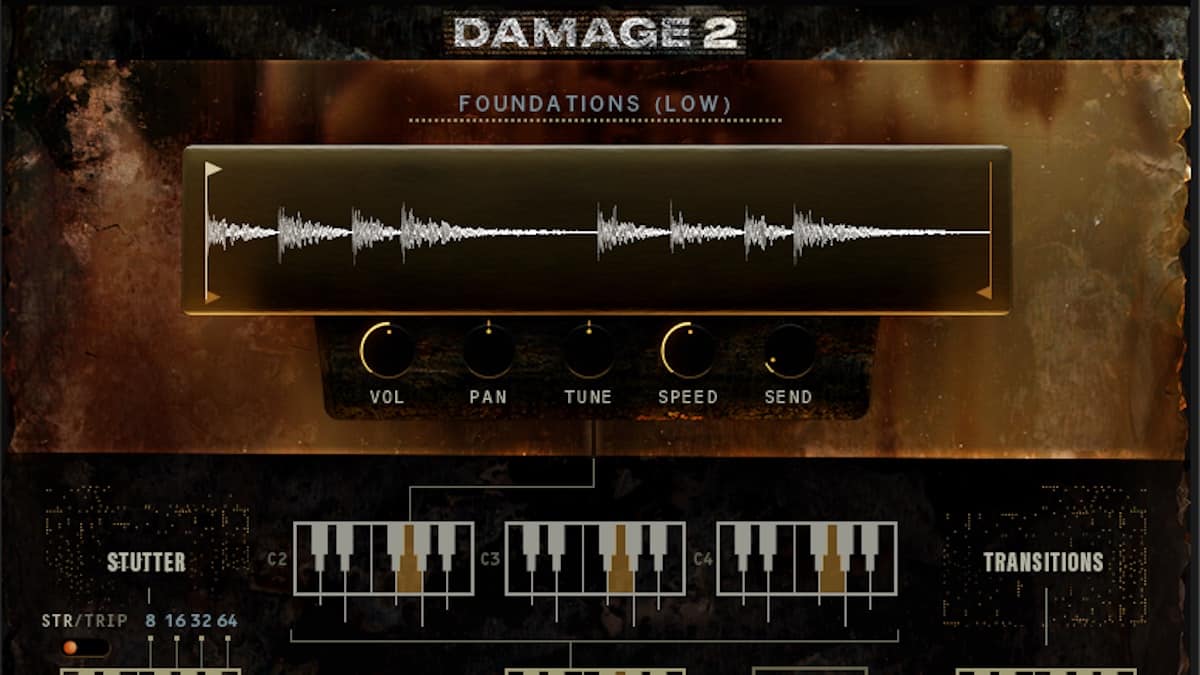In This Issue
Review: New Heavyocity Damage 2 Percussion Library

Heavyocity’s Damage 2 is an epic sequel that offers innovative new features, a wealth of new loops, and deeply sampled instruments.
Heavyocity set an incredibly high bar when they unleashed their original cinematic hybrid percussion library, Damage, back in 2011. Punchy, detailed, and expertly produced, Damage (D1) quickly became the go-to Kontakt instrument for media composers on the hunt for hard-hitting, massive drums and percussion with a modern, stylized twist.
Damage 2 (D2) is an epic sequel that continues the aesthetic of its predecessor while offering innovative new features and a wealth of new loops and deeply sampled instruments sure to make their way into countless game, TV, and film soundtracks for years to come.
To be clear, D2 is an entirely new soundset created from sample sessions recorded at the legendary Skywalker Sound studios, not a repackage or redux on existing material. As with D1, D2’s instruments are presented with multiple microphone perspectives – close, room, and hall, plus LFE and “crush” mic signals, which are new options in D2.
Source content is organized into nine categories that follow now-familiar Damage themes: Monster Ens, Organic, Taikos, Ethnic, Cymbals, and Gongs, Found Sounds, Hybrid, Damaged, and Transitions. Check out our patch audition video to hear examples from each category:
One of the immediate differences between D1 and D2 is the way patches are organized and accessed. With D2, there are simply three “instruments” (Ensemble Designer, Kit Designer, and Loop Designer) within which you can select patches via Kontakt’s snapshot menu. Each of the Designers shares common elements, such as the Master FX page and Source page where you can easily assign instruments, hits, and loops to MIDI notes via the intuitive drag-and-drop interface.
This is a huge leap over D1 because it allows you to create your own instrument and loop combinations mapped to your liking within a defined key range – a level of user customization that was virtually impossible with D1. What’s more, this kind of flexibility spurs creativity and can lead you in interesting compositional directions as you dig into D2’s content.
The Ensemble Designer’s Settings page houses Heavyocity’s new MIDI Performance Tool, which you can use to trigger articulations such as flams and crescendos, as well as repeating patterns of varying lengths and subdivisions (e.g. 1/16 notes, 1/4 note triplets, etc.) from a single key. MIDI processing engines such as this are not new, but Heavyocity’s implementation in D2 is especially effective for creating ultra-realistic performances quickly. Indeed, this feature makes short work of programming driving patterns and dramatic flourishes – and the results are extremely convincing.
Also new in D2 is the Kit Designer, which features 16 virtual pads for triggering one-shots and is designed to integrate with NI’s Machine or MPC-style controllers. It’s a fun way to play D2’s sounds and offers the ability to apply up to four effects per drum, which is not possible with the Ensemble Designer. For those who prefer pad controllers to keyboards, the Kit Designer will undoubtedly be the instrument of choice.
The Loop Designer uses a similar mapping approach from Heavyocity’s Gravity, whereby low, mid, and high frequency loops are mapped across three octaves respectively, with the ability to trigger “loop stacks” (low, mid, and high combined) using “Designer Keys” mapped from C1 to B1. I’ve long been a fan of this interface design, because it puts a ton of rhythmic potential under your fingertips for easy experimentation and there’s a certain instant gratification factor that can help kick start ideas. And thanks to the built-in master and send effects, you can polish and warp the loops well beyond their original sonic characteristics.
That said, D2’s loops are not presented in individual slice format with corresponding MIDI performances (similar to REX files), which is a major disappointment. This was a selling point with D1, and I suspect many users will lament the loss of this feature. Shortcomings aside, D2’s 864 loops represent a veritable treasure trove of rhythmic inspiration, with plenty of subtle and bombastic material to choose from. Take a look and listen

Conclusions
Damage 2 is an undeniable champion in the arena of hybrid cinematic percussion and will surely become a favorite among producers and composers who need cutting edge, thunderous, and highly dynamic drums and percussion. It’s a massive collection that runs the gamut from forceful and organic to hybrid and damaged (i.e., extreme sound design) built into an innovative set of instrument interfaces that are a joy to work with.
Imminently playable, creative and musically satisfying, Damage 2 sets a new standard for epic drums. Highly recommended!
Website: https://heavyocity.com/product/damage-2
Supported platforms: Native Instruments Kontakt/Kontakt Player 6.2.2 or later
Price: $399


















